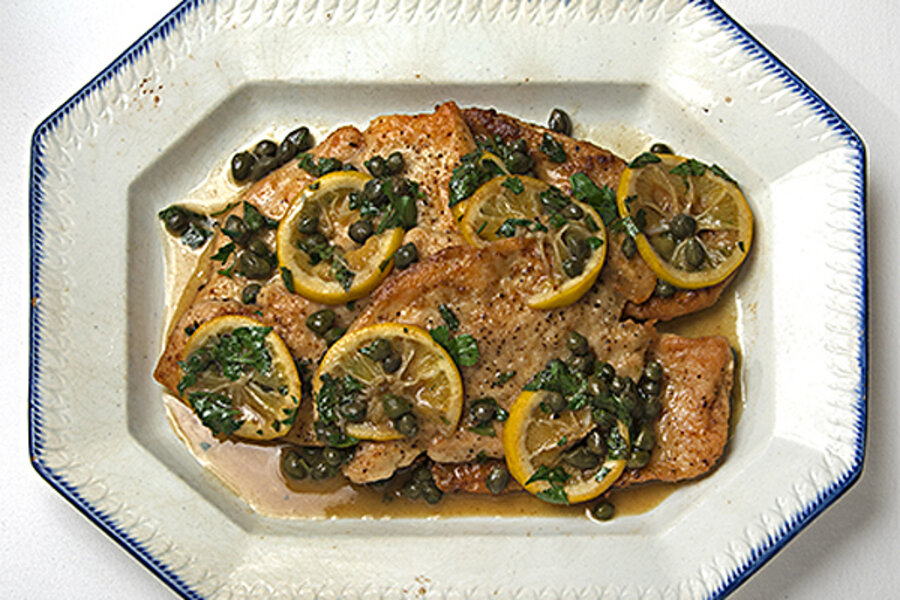Chicken piccata, buttery and lemon bright
Loading...
It’s week three of Butterfest at Blue Kitchen. Last week, my Hake with Lentils and Sage Mustard Butter had 5-1/2 tablespoons of butter. And while Marion’s Chevre Cheesecake with Hazelnut Crust two weeks ago only used two tablespoons, dairy was otherwise well represented, with cream cheese, goat cheese, and sour cream.
Based on the classic Italian dish veal piccata, this chicken piccata recipe requires a rather modest half stick of butter, four tablespoons. And requires is the operative term here – the buttery richness plays beautifully against the tart brightness of the capers and lemons.
The lemons in question are Meyer lemons grown by fellow blogger Christina, whose A Thinking Stomach is loaded with useful information and thoughtful observations on gardening and food. These are not armchair tales. The stories all come from her own experiences in her bountiful Southern California garden. What comes through in Christina’s eloquent writings is her love of growing things as well as a clear-eyed recounting of just how much hard work is involved.
We’ve “known” Christina for at least seven years now, although we’ve never actually met or even spoken on the phone. This is the second time she’s generously shared her harvest with us, shipping us beautiful Meyer lemons she picked from her own trees.
Meyer lemons are a hybrid of true lemons (either Lisbon or Eureka) and mandarin oranges. They’re popular as ornamental trees in California, having a compact shape, fragrant flowers and shiny, dark green leaves. Increasingly, though, chefs and home cooks are bringing their fruit into the kitchen. It is sweeter and less acidic than standard issue lemons, with a slight floral quality. The skins are thinner and may have a hint of orange color when ripe.
For this recipe, you can substitute regular lemons. But if at all possible, track down some Meyer lemons. They’ll deliver loads of bright, tangy kick with less mouth-puckering sourness.
The term piccata, when referring to Italian cooking, specifically means cooked, sauced, or served with lemon and parsley (and often capers). Descriptively, it means “tasty, savory, spicy, piquant.” Veal piccata is probably the best known version, but chicken piccata is popular, too. You can also use turkey or pork cutlets.
In all cases, the meat is sliced and/or pounded very thin, then dredged in flour and sautéed in butter or a mix of butter and oil. It is then topped with a lemon butter parsley caper sauce. Variations can include shallots, garlic, wine, and paprika. However your piccata dish comes together, you’ll end up with something that tastes far too good to be so easy. When you serve it, be sure to eat the lemon slices – and encourage others to do so. You will be rewarded with citrusy bursts of wonderfulness. (Here is where the Meyer lemon’s thinner skin is a definite advantage.)
Chicken piccata
Serves 2
2 boneless, skinless chicken breast halves (about 1 pound total)
Salt and freshly ground pepper
Flour
4 tablespoons butter, divided
2 tablespoons olive oil
3/4 cup white wine [optional, may substitute cooking wine]
3/4 cup chicken broth
1 Meyer lemon, thinly sliced (or a regular lemon)
1/4 cup capers, drained
1/4 cup coarsely chopped parsley
1 tablespoon Meyer lemon juice (or, again, regular lemon)
1. Butterfly chicken breast halves (you’ll find a step-by-step guide here) and divide each into two thin fillets. Place fillets between two sheets of plastic wrap and pound to 1/4-inch thickness. You can use the flat side of a meat tenderizer or the bottom of a skillet (work on top of a cutting board to protect your counter surface).
2. Season chicken with salt and pepper and dredge in flour, shaking off excess. Heat a large skillet over medium flame and melt 2 tablespoons of butter with the olive oil, swirling to combine. Working in batches, brown chicken fillets, turning once, about 3 minutes per side. Transfer to a platter and tent with foil to keep warm (you can also place it in a warm oven).
3. Add wine to pan and cook until reduced by half, scraping up any browned bits, about 2 to 3 minutes. Add stock and lemon slices to pan. Bring to a boil, reduce heat and simmer until slightly reduced, 4 to 7 minutes. Add remaining butter, capers, parsley and lemon juice. Stir until butter is just melted and everything is combined. Spoon sauce over chicken and serve immediately.








